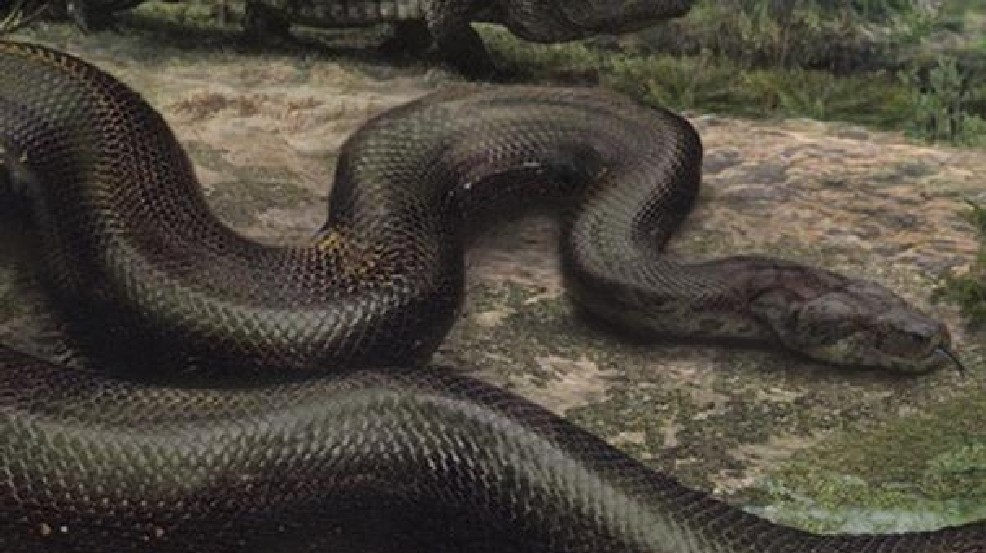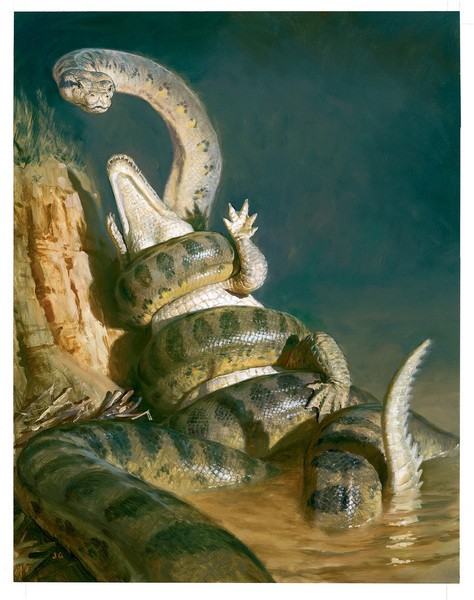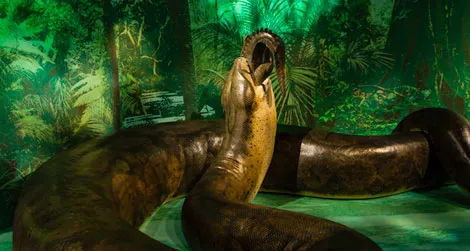You would think this was something out of a Harry Potter movie. But it actually existed, as scientists have discovered.
In 2009, coal miners and scientists discovered more than 180 fossils of a gargantuan snake in a Colombian region called Cerrejon. The conclusion from the finding was that 60 million years ago after dinosaurs had already gone extinct, the Titanboa snake was roaming around the jungle.
It was a 45-foot monster, three times bigger than your average crocodile.
Colombian geologist Henry Garcia is credited with being the first to kick off the discovery. He found an unfamiliar fossil and placed it in a company coal case.
Fabiany Herrera, a geology student nearby, discovered the impression of a fossil leaf on a rock several years after that. In 2003, an expedition began by coal miners, scientists, and paleontologists to study the area more thoroughly.
Their findings not only led them to the Titanboa snake but also other abnormally large species that lived in the region.

A Fossil Treasure Trove
Anyone who visits northern Colombia and comes across Cerrejon, situated 60 miles off the Caribbean coast, will find a whole lot of nothing. It reminds you of the empty deserts in the Western US with a whole lot of dirt and sand.
All you’ll find around here are some coal miners, dump trucks, and other construction vehicles roaming around the dirt roads. Also situated here is Carbones del Cerrejon Limited, a multinational coal corporation responsible for extracting millions of tons of coal per year.
Besides coal workers, though, you will find the area visited by scientists, geologists, and archaeologists. That’s because Cerrejon is one of the world’s richest fossil deposit regions, and the world’s smartest people will come to this place to explore and search for fossils.
“Cerrejón is the best, and probably the only, window on a complete ancient tropical ecosystem anywhere in the world,” said Carlos Jaramillo, a paleontologist at the Smithsonian Tropical Research Institute. “The plants, the animals, everything. We have it all, and you can’t find it anywhere else in the tropics.”
Cerrejon wasn’t always an open area of land. In fact, it was filled with swampy jungles and hundreds of trees. It was notoriously hotter and wetter than what it exists today.
They received twice as much rain millions of years ago than they do today, and that helped create the perfect living environment for some of nature’s most incredible creatures. The climate was so warm and humid that it was perfect for large animals to grow in historic size.
It was first the home of dinosaurs more than 60 to 80 million years ago. After they became extinct when a giant asteroid impacted Earth, it was replaced with tropical rainforests and jungles that birthed various animals and species.
The jungle during the Paleocene period was the home to turtles twice the size of what exists today. There were three different crocodile species, all larger than what we’re used to seeing in lakes.
There was also a snake that measured more than 40 feet long and weighed over 2,500 pounds. Once the dinosaurs passed on, this became the new “King of the Jungle.”
The Titanboa
The Titanboa snake was in simple terms “a monster.” It can best be compared today to a boa constrictor with the behavior of an anaconda.
But even the largest boas and anacondas today don’t reach anywhere near 40 feet long. The average anaconda is about one-third of that.
Not to mention the Titanboa was so thick that it could reach up to a man’s waist from the ground up. In essence, it was the largest snake in the history of the world.
Scientists concluded that the large giant turtle shells and crocodile fossils that were found were likely victims of the snake that devoured them. Its brown skin was the perfect camouflage for roaming the jungles and hunting its prey.
With the dinosaurs gone, there wasn’t an animal that stood a shot against the serpent. Even King Kong would struggle to fight off the Titanboa.

How the Titanboa Was Uncovered
Garcia’s finding of an unfamiliar fossil combined with Herrera’s discovery of a fossil leaf got heads thinking that once upon a time, this land could have been a breeding ground for a jungle. The question was, “What was in that jungle?”
Further studies were completed that showed this was one of the first tropical rainforests. As they dug for fossils, they found specimens and fossils of giant turtles, crocodiles, bean plants, and even the world’s first bananas.
Then they found a gigantic vertebra of an incredibly large snake. This led to more digging and more evidence of an enormous creature.
The goal of the scientists was to find the skull, which was the hardest part of the discovery. They uncovered 100 snake vertebrae from 28 different animals as they dug, but they only found three skull fragments.
Still, what they found was enough to piece together a 45-foot giant, and given how many pieces were in other animals, they concluded that this was a beast that dominated this jungle. It was like the Tyrannosaurus Rex, ruling over the rainforest.

In 2012, the Smithsonian set up an exhibit in Grand Central Station depicting the Titanboa based on the fossil discoveries. Mock-ups were drawn up, including a promotional video showing the Titanboa facing off against the Tyrannosaurus.
Some scientists have clashed with those who concluded the snake was as large as it was. However, they do admit it was an incredibly large specimen.
As for what killed the Titanboa, the theory is a massive mudslide destroyed everything in the rainforest, including the snake. This mudslide caused all the fossils to be buried deep under the earth.
References
Gugliotta, Guy. “How Titanboa, the 40-foot Snake, Was Found.” SmithsonianMag.com. April 2012. https://www.smithsonianmag.com/science-nature/how-titanoboa-the-40-foot-long-snake-was-found-115791429/.
DeLong, William. “Meet Titanboa, the Prehistoric Snake of our Nightmares.” AllThatsInteresting.com. 15 Oct 2022. https://allthatsinteresting.com/titanoboa-snake.

